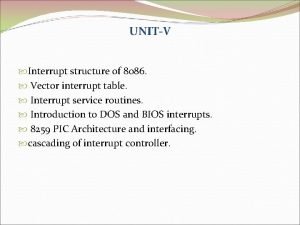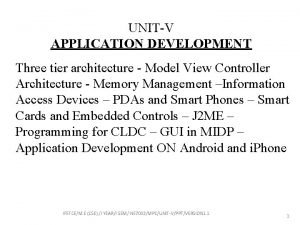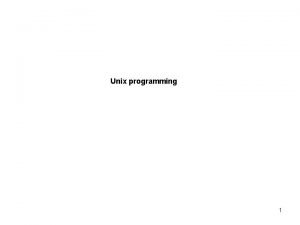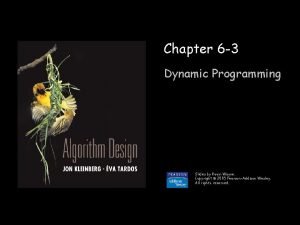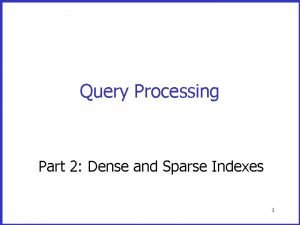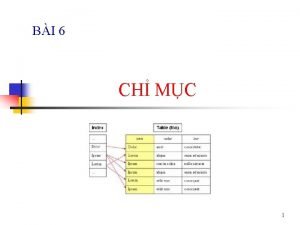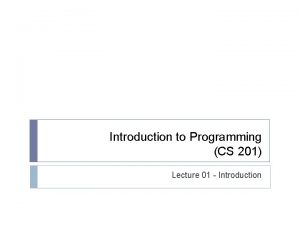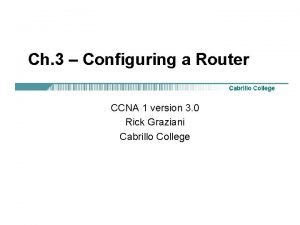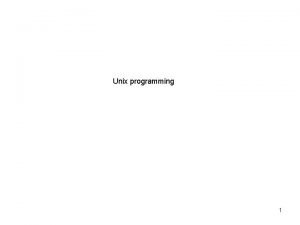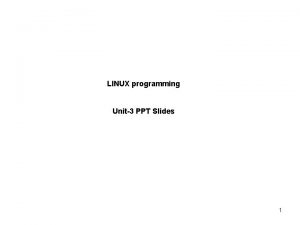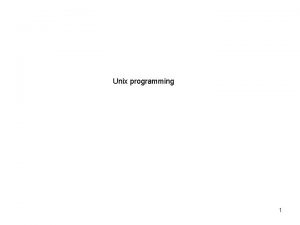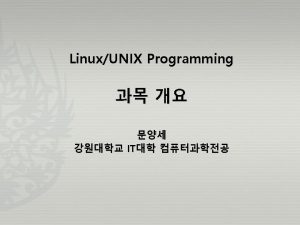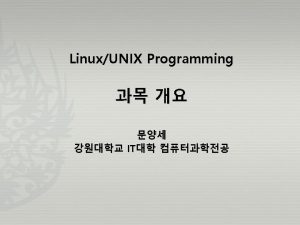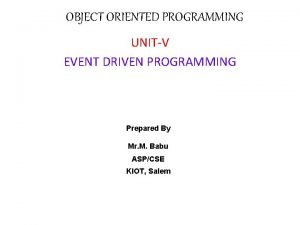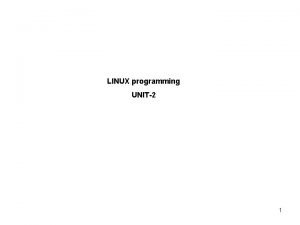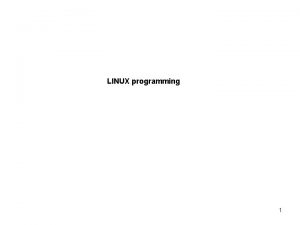Unix programming 1 INDEX UNITV I PPT SLIDES






![Eg: int glob = 6; char buf[] = "a write to stdoutn"; int main(void) Eg: int glob = 6; char buf[] = "a write to stdoutn"; int main(void)](https://slidetodoc.com/presentation_image_h/a5af1536091d54f48238bc37c1e5d7e5/image-7.jpg)





























- Slides: 36

Unix programming 1

INDEX UNIT-V I PPT SLIDES Srl. No. Module as per Session planner Lecture No. PPT Slide 1. Process, process structure L 1 3 -5 2. Starting new process, waiting for a process L 2 6 -8 3. Zombie process, process control L 3 9 -10 4. Process identifiers, fork, vfork, exit, wait, exe L 4 11 -19 5. Signal functions, unreliable signals L 5 20 -24 6. Interrupted system calls, kill, raise functions L 6 25 -29 7. Alarm, pause, abort, system , sleep functions L 7 51 -54 8. Revision 2

Process , Process structure: • Every process has a unique process ID, a non -negative integer. Unique, process IDs are reused. As processes terminate, their IDs become candidates for reuse. • Process ID 0 is usually the scheduler process and is often known as the swapper. • Process ID 1 is usually the init process and is invoked by the kernel at the end of the bootstrap procedure. The init process never dies. • process ID 2 is the page daemon. 3 L 1. 1

• In addition to the process ID, there are other identifiers for every process. The following functions return these identifiers. #include <unistd. h> pid_t getpid (void); Returns: process ID of calling process. pid_t getppid (void); Returns: parent process ID of calling process. uid_t getuid (void); Returns: real user ID of calling process. L 1. 2 4

uid_t geteuid (void); Returns: effective user ID of calling process gid_t getgid (void); Returns: real group ID of calling process. gid_t getegid (void); Returns: effective group ID of calling process. • None of these functions has an error return. L 1. 3 5

fork Function: • An existing process can create a new one by calling the fork function. #include <unistd. h> pid_t fork(void); Returns: 0 in child, process ID of child in parent, -1 on error. The new process created by fork is called the child process. This function is called once but returns twice. The only difference in the returns is that the return value in the child is 0, whereas the return value in the parent is the 6 L 2. 1 process ID of the new child.
![Eg int glob 6 char buf a write to stdoutn int mainvoid Eg: int glob = 6; char buf[] = "a write to stdoutn"; int main(void)](https://slidetodoc.com/presentation_image_h/a5af1536091d54f48238bc37c1e5d7e5/image-7.jpg)
Eg: int glob = 6; char buf[] = "a write to stdoutn"; int main(void) { int var; pid_t pid; var = 88; if (write(STDOUT_FILENO, buf, sizeof (buf)-1) != sizeof (buf)-1) err_sys("write error"); printf("before forkn"); if ((pid = fork()) < 0) { L 2. 2 err_sys("fork error"); 7

else if (pid == 0) { glob++; var++; } else { sleep(2); } printf("pid = %d, glob = %d, var = %dn", getpid(), glob, var); exit(0); } L 2. 3 8

$. /a. out a write to stdout before fork pid = 430, glob = 7, var = 89 pid = 429, glob = 6, var = 88 uses fork: 1. When a process wants to duplicate itself so that the parent and child can each execute different sections of code at the same time. 2. When a process wants to execute a different program. This is common for shells. L 2. 4 9

vfork : • The function vfork has the same calling sequence and same return values as fork. • The vfork function creates the new process, just like fork, without copying the address space of the parent into the child, as the child won't reference that address space. • vfork guarantees that the child runs first, until the child calls exec or exit. When the child calls either of these functions, the parent resumes. L 2. 5 10

exit : A process can terminate normally in five ways: 1. Executing a return from the main function. 2. Calling the exit function. 3. Calling the _exit or _Exit function. 4. Executing a return from the start routine of the last thread in the process. 5. Calling the pthread_exit function from the last thread in the process. Once the process terminates, the kernel closes all the open descriptors for the process, L 4. 1 11 releases the memory that it was using.

Exit Functions Three functions terminate a program normally: _exit and _Exit, which return to the kernel immediately, and exit, which performs certain cleanup processing and then returns to the kernel. #include <stdlib. h> void exit( int status); void _Exit( int status); #include <unistd. h> void _exit( int status); L 4. 2 12

wait and waitpid Functions: #include <sys/ wait. h> pid_t wait(int *statloc); pid_t waitpid( pid_t pid, int *statloc, int options); Both return: process ID if OK, or -1 on error. • The wait function can block the caller until a child process terminates, whereas waitpid has an option that prevents it from blocking. • The waitpid function doesn't wait for the child that terminates first; it has a number of options that control which process it waits for. L 4. 3 13

For both functions, the argument statloc is a pointer to an integer. If this argument is not a null pointer, the termination status of the terminated process is stored in the location pointed to by the argument. The interpretation of the pid argument for waitpid depends on its value: pid == 1 Waits for any child process. pid > 0 Waits for the child whose process ID equals pid == 0 Waits for any child whose process group ID equals that L 4. 4 of the calling process. 14

pid < 1 Waits for any child whose process group ID equals the absolute value of pid. The options constants for waitpid: WCONTINUED WNOHANG WUNTRACED The waitpid function returns the process ID of the child that terminated and stores the child's termination status in the memory location pointed to by statloc. L 4. 5 15

exec Functions: • Exec replaces the current process its text, data, heap, and stack segments with a brand new program from disk. • with the exec functions, we can initiate new programs. There are six different exec functions. L 4. 6 16

#include <unistd. h> int execl (const char *pathname, const char *arg 0, . . . /* (char *)0 */ ); int execv (const char *pathname, char *const argv []); int execle (const char *pathname, const char *arg 0, . . . /* (char *)0, char *const envp[] */ ); int execve (const char *pathname, char *const argv[], char *const envp []); int execlp (const char *filename, const char *arg 0, . . . /* (char *)0 */ ); int execvp (const char *filename, char *const 17 L 4. 7

All six return: 1 on error, no return on success. • The first difference in these functions is that the first four take a pathname argument, whereas the last two take a filename argument. When a filename argument is specified If filename contains a slash, it is taken as a pathname. Otherwise, the executable file is searched for in the directories specified by the PATH environment variable. L 4. 8 18

• The functions execl, execlp, and execle require each of the command-line arguments to the new program to be specified as separate arguments. We mark the end of the arguments with a null pointer. • For the other three functions (execv, execvp, and execve), we have to build an array of pointers to the arguments, and the address of this array is the argument to these three functions. L 4. 8 19

Signals: • Signals are software interrupts. Signals provide a way of handling asynchronous events. • Every signal has a name. These names all begin with the three characters SIG. These names are all defined by positive integer constants (the signal number) in the header <signal. h>. • No signal has a signal number of 0. L 5. 1 20

Signal Function: • The simplest interface to the signal features of the UNIX System is the signal function. include <signal. h> void (*signal(int signo, void (*func)(int)))(int); Returns: previous disposition of signal if OK, SIG_ERR on error. • The signo argument is just the name of the signal. The value of func is (a) the constant SIG_IGN, (b) the constant SIG_DFL, or (c) the address of a function to be called when 21 the signal occurs.

Simple program to catch SIGUSR 1 & SIGUSR 2 static void sig_usr (int); int main(void) { if (signal(SIGUSR 1, sig_usr) == SIG_ERR) err_sys("can't catch SIGUSR 1"); if (signal(SIGUSR 2, sig_usr) == SIG_ERR) err_sys("can't catch SIGUSR 2"); for ( ; ; ) pause(); L 5. 2 } 22

static void sig_usr (int signo) { if (signo == SIGUSR 1) printf("received SIGUSR 1n"); else if (signo == SIGUSR 2) printf("received SIGUSR 2n"); else err_dump("received signal %dn", signo); } L 5. 3 23

Unreliable Signals: Unreliable signals mean that signals could get lost: a signal could occur and the process would never know about it. Also, a process had little control over a signal: a process could catch the signal or ignore it. L 5. 4 24

Interrupted System Calls: • It is a system call within the kernel that is interrupted when a signal is caught. • To support this feature, the system calls are divided into two categories: the "slow" system calls and all the others. • The slow system calls are those that can block forever. L 6. 1 25

• Reads that can block the caller forever if data isn't present with certain file types. • Writes that can block the caller forever if the data can't be accepted immediately by these same file types. • Opens that block until some condition occurs on certain file types. • The pause function and the wait function. • Certain ioctl operations. • Some of the interprocess communication functions. L 6. 2 26

kill and raise Functions: • The kill function sends a signal to a process or a group of processes. • The raise function allows a process to send a signal to itself. #include <signal. h> int kill( pid_t pid, int signo); int raise(int signo); Both return: 0 if OK, -1 on error. L 6. 3 27

There are four different conditions for the pid argument to kill. pid > 0 The signal is sent to the process whose process ID is pid == 0 The signal is sent to all processes whose process group ID equals the process group ID of the sender and for which the sender has permission to send the signal. pid < 0 The signal is sent to all processes whose process group ID equals the absolute value of pid and for which the sender has permission to send the signal. L 6. 4 28

pid == 1 The signal is sent to all processes on the system for which the sender has permission to send the signal. • The super user can send a signal to any process. L 6. 5 29

alarm function: • The alarm function allows us to set a timer that will expire at a specified time in the future. • When the timer expires, the SIGALRM signal is generated. #include <unistd. h> unsigned int alarm(unsigned int seconds); Returns: 0 or number of seconds until previously set alarm. The seconds value is no. of clock seconds in the future when the signal should be generated. 30 L 7. 1

• If, when we call alarm, a previously registered alarm clock for the process has not yet expired, the number of seconds left for that alarm clock is returned as the value of this function. • If a previously registered alarm clock for the process has not yet expired and if the seconds value is 0, the previous alarm clock is canceled. The number of seconds left for that previous alarm clock is still returned as the value of the function. L 7. 2 31

pause function: • The pause function suspends the calling process until a signal is caught. #include <unistd. h> int pause(void); Returns: 1 with errno set to EINTR • The only time pause returns is if a signal handler is executed and that handler returns. L 7. 3 32

abort Function: • The abort function causes abnormal program termination. #include <stdlib. h> void abort(void); This function never returns. • This function sends the SIGABRT signal to the caller. L 7. 4 33

system Function: • It is convenient to execute a command string from within a program. #include <stdlib. h> int system(const char *cmdstring); • If cmdstring is a null pointer, system returns nonzero only if a command processor is available. This feature determines whether the system function is supported on a given operating system. Under the UNIX System, system is always available. L 7. 5 34

The system is implemented by calling fork, exec, and waitpid, there are three types of return values. • If either the fork fails or waitpid returns an error , system returns 1 with errno set to indicate the error. • If the exec fails, implying that the shell can't be executed, the return value is as if the shell had executed exit(127). • Otherwise, all three functions fork, exec, and waitpid succeed, and the return value from system is the termination status of the shell, in L 7. 6 35 the format specified for waitpid.

sleep Function: #include <unistd. h> unsigned int sleep(unsigned int seconds); Returns: 0 or number of unslept seconds. This function causes the calling process to be suspended until either • The amount of wall clock time specified by seconds has elapsed. The return value is 0. • A signal is caught by the process and the signal handler returns. Return value is the number of unslept seconds. L 7. 7 36
 Unitv pin
Unitv pin Process flow of web interface design in hci
Process flow of web interface design in hci Characteristics of multiprocessor system
Characteristics of multiprocessor system Interrupt table
Interrupt table Unitv
Unitv Unitv download
Unitv download 3 tier architecture ppt
3 tier architecture ppt Unitv android
Unitv android Raw sockets in unix network programming
Raw sockets in unix network programming Unix and network programming
Unix and network programming Unix operating system
Unix operating system Unix programming
Unix programming A small child slides down the four frictionless slides
A small child slides down the four frictionless slides John pushes hector on a plastic toboggan
John pushes hector on a plastic toboggan Unix tutorial ppt
Unix tutorial ppt Class counter
Class counter Dynamic programming slides
Dynamic programming slides Diff between step index and graded index fiber
Diff between step index and graded index fiber Dense secondary index
Dense secondary index Morphological index and bacteriological index
Morphological index and bacteriological index Physical quality of life index and human development index
Physical quality of life index and human development index Diff between step index and graded index fiber
Diff between step index and graded index fiber Simpson diversity index
Simpson diversity index Plasticity index chart of soil
Plasticity index chart of soil Clustered index và non clustered index
Clustered index và non clustered index Perbedaan linear programming dan integer programming
Perbedaan linear programming dan integer programming Greedy vs dynamic
Greedy vs dynamic Runtime programming
Runtime programming Integer programming vs linear programming
Integer programming vs linear programming Definisi linear
Definisi linear Mailbox in systemverilog
Mailbox in systemverilog Acknowledgement powerpoint slide
Acknowledgement powerpoint slide Respiration mitochondria
Respiration mitochondria Cs201 ppt slides
Cs201 ppt slides Ccna 200-301 ppt slides download
Ccna 200-301 ppt slides download Ppt index
Ppt index Enterprise resource planning lecture notes ppt
Enterprise resource planning lecture notes ppt



